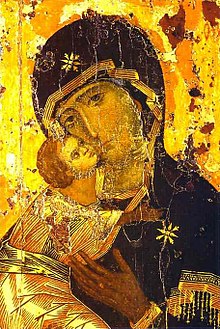
Mariology is the Christian theological study of Mary, the mother of Jesus.[3] Mariology seeks to relate doctrine or dogma about Mary to other doctrines of the faith, such as those concerning Jesus and notions about redemption, intercession and grace. Christian Mariology aims to place the role of the historic Mary in the context of scripture, tradition and the teachings of the Church on Mary.[4][5][6] In terms of social history, Mariology may be broadly defined as the study of devotion to and thinking about Mary throughout the history of Christianity.[7]
There exist a variety of Christian (and non-Christian) views on Mary as a figure ranging from the focus on the veneration of Mary in Roman Catholic Mariology to criticisms of "mariolatry" as a form of idolatry. The latter would include certain Protestant objections to Marian devotion. There are also more distinctive approaches to the role of Mary in Lutheran Mariology and Anglican Marian theology.[8][9] As a field of theology, the most substantial developments in Mariology (and the founding of specific centers devoted to its study) in recent centuries have taken place within Roman Catholic Mariology. Eastern Orthodox concepts and veneration of Mary are integral to the rite as a whole, (the theotokos) and are mostly expressed in liturgy. The veneration of Mary is said to permeate, in a way, the entire life of the Church as a "dimension" of dogma as well as piety, of Christology as well as of Ecclesiology. While similar to the Roman Catholic view, barring some minor differences, the Orthodox do not see a need for a separate academic discipline of Mariology, as the Mother of God is seen as the self-evident apogee of God's human creation.[10]
A significant number of Marian publications were written in the 20th century, with theologians Raimondo Spiazzi and Gabriel Roschini producing 2500 and 900 publications respectively. The Pontifical Academy of Mary and the Pontifical Theological Faculty Marianum in Rome are key Mariological centers.
- ^ The icon handbook: a guide to understanding icons and the liturgy by David Coomler 1995 ISBN 0872432106 p. 203.
- ^ The era of Michelangelo: masterpieces from the Albertina by Achim Gnann 2004 ISBN 8837027559 p. 54.
- ^ Llywelyn, Dorian SJ (June 2016). "Oxford Handbooks Online – Mary and Mariology". doi:10.1093/oxfordhb/9780199935420.013.62. ISBN 978-0199935420.
- ^ The encyclopedia of Christianity, Volume 3 by Erwin Fahlbusch, Geoffrey William Bromiley 2003 ISBN 9004126546 pp. 403–404.
- ^ Rahner, Karl 2004 Encyclopedia of theology: a concise Sacramentum mundi ISBN 0860120066 p. 901.
- ^ Hillerbrand, Hans Joachim. Encyclopedia of Protestantism, Volume 3 2003. ISBN 0415924723 p. 1174.
- ^ Encyclopedia of Social History (ISBN 0815303424 p. 573) states: "More broadly defined, Mariology is the study of devotion to and thinking about Mary throughout the history of Christianity."
- ^ Cite error: The named reference
McNabbFennell2019was invoked but never defined (see the help page). - ^ Cite error: The named reference
Karkan2017was invoked but never defined (see the help page). - ^ Schmemann, Alexander (1970) "On Mariology in Orthodoxy," Marian Library Studies: Vol. 2, Article 4, pp. 25–32. Available at: http://ecommons.udayton.edu/ml_studies/vol2/iss1/4